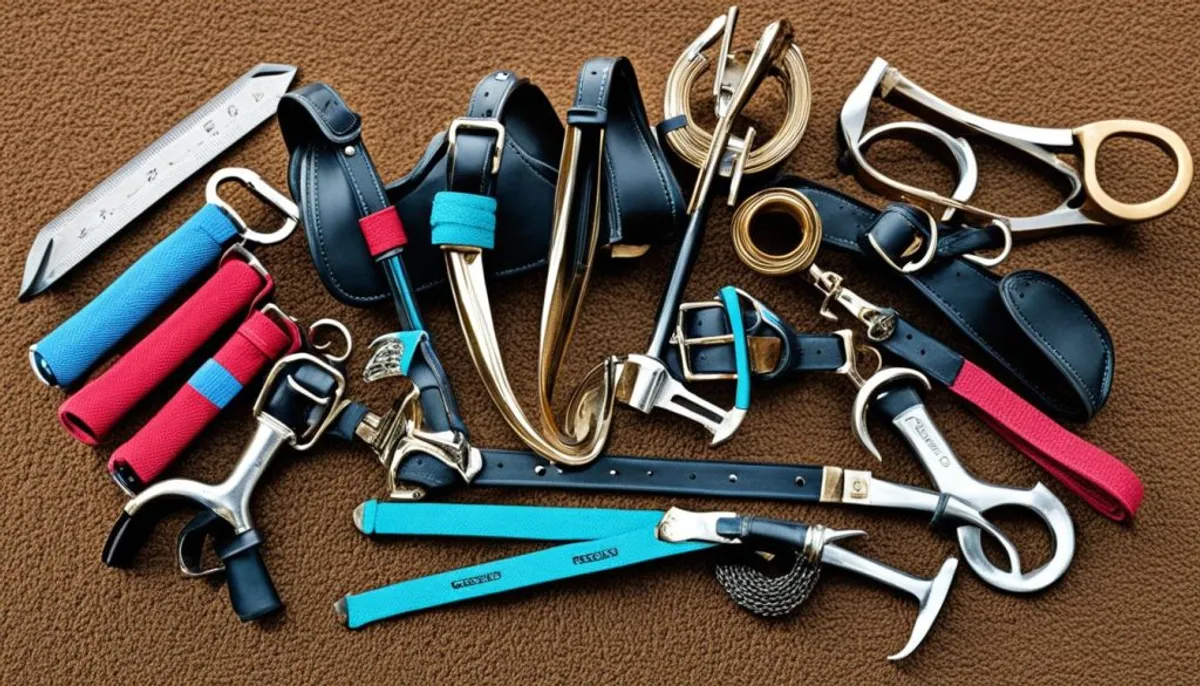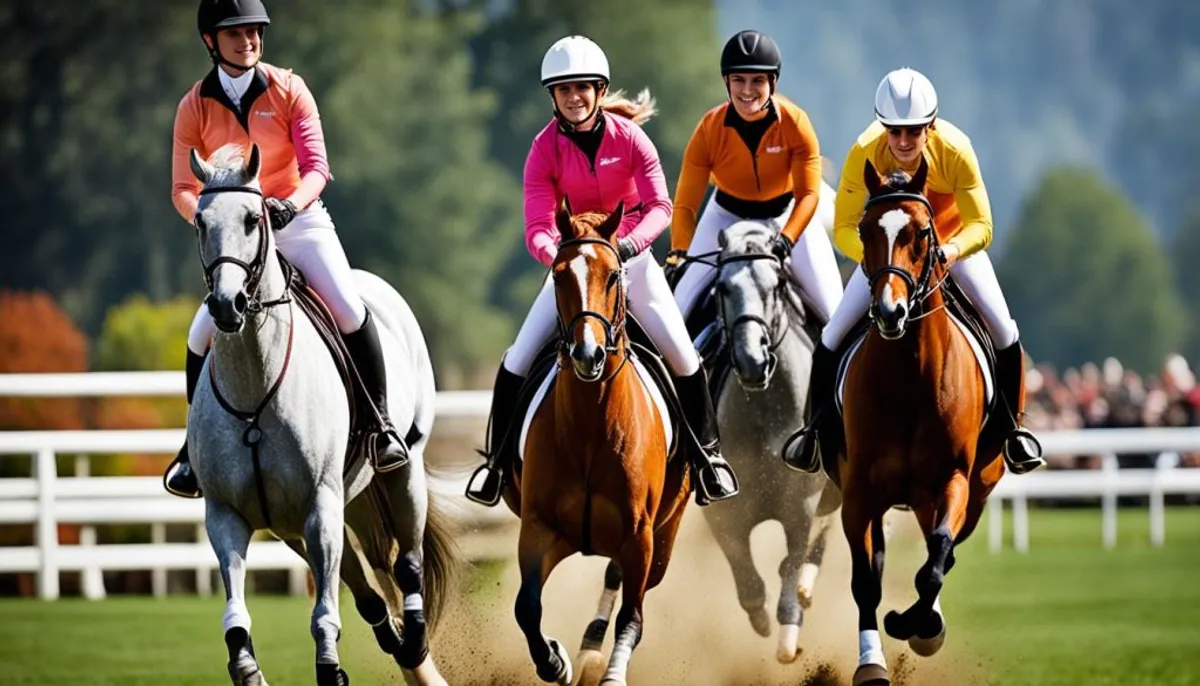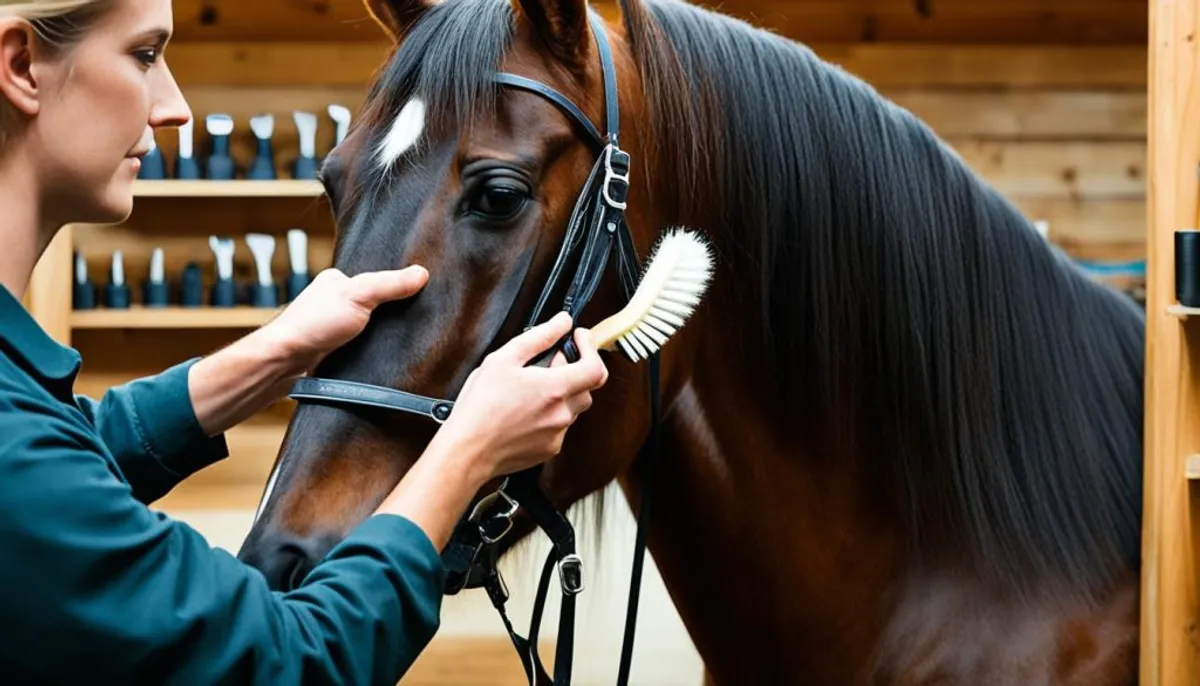The world of horseback riding is full of specific terms. These terms are key to effectively communicate in this exciting world. They cover everything from the names of the parts of the horse to the names of the equipment and gaits.
Learning this vocabulary is crucial for integrating into the equestrian community. It also helps to understand the instructions from trainers and to share observations about the health and performance of one's horse.
This guide shows you the key terms of horseback riding. It helps you communicate better and understand this captivating universe. Whether you are a beginner or an experienced rider, immerse yourself in this fascinating world.

Main Takeaways
- The vocabulary of horseback riding is essential for effective communication in the equestrian sports environment.
- Mastering this lexicon allows for better understanding of trainers' instructions and sharing observations about the health and performance of one's horse.
- This guide will help you discover and assimilate the key terms of horseback riding.
- Learning this equestrian vocabulary, from equestrian equipment to equestrian expressions, will allow you to immerse yourself in this exciting universe.
- Whether you are a beginner or an experienced rider, mastering this lexicon is crucial for integrating into the equestrian community.
Introduction
Learning equestrian vocabulary is crucial for any rider, regardless of their level. Horseback riding is an international sport. Knowing the terms in French facilitates integration in various contexts, such as competitions or trips abroad.
Using the equestrian lexicon correctly improves communication with trainers and other riders. It also helps convey key information about horses.
Why is it important to know equestrian vocabulary?
Knowing this vocabulary opens the door to many educational resources. You will find manuals and instructional videos in French. This enriches your knowledge of horseback riding and equestrian sports.
In conclusion, mastering the equestrian lexicon is vital for better understanding and communication in the equestrian world, whether in France or elsewhere.
Basic Vocabulary
Learning the basic terms of equestrian vocabulary is crucial for those interested in horseback riding. It is important to know the parts of the horse, the key equestrian equipment, and the people in the field.
The parts of the horse are essential to know. Terms like “hoof,” “mane,” and “tail” help describe the horse accurately.
The basic equestrian equipment is also crucial. This includes the “saddle,” “bridle,” and “stirrups.” These tools are indispensable for the rider.
The people in the field play an important role in equestrian vocabulary. The “rider” is the one who rides the horse. The “farrier” takes care of the hooves.
| Basic Equestrian Terms | Parts of the Horse | Equestrian Equipment | People in the Field |
|---|---|---|---|
| Vocabulary | Hoof, mane, tail | Saddle, bridle, stirrups | Rider, farrier |
Understanding these basic terms improves communication in the world of horseback riding. It is the first step to diving into this exciting world.

Equestrian Vocabulary
The vocabulary of horseback riding is crucial for riders. It includes many specific equestrian terms. These terms cover everything from the names of the parts of the horse to the names of the equipment and gaits.
Understanding this equestrian vocabulary helps integrate into the equestrian community. It also allows one to follow the advice of trainers and discuss the health and performance of the horse. This is essential for any rider, regardless of their level.
- The different parts of the horse: neck, withers, flank, fetlock, hoof, etc.
- The gaits: walk, trot, canter, amble, passage, etc.
- The movements: piaffe, rearing, bucking, etc.
- The equipment: saddle, bridle, bit, stirrup, whip, etc.
Mastering this equestrian vocabulary is an asset for any rider. It improves communication and mutual understanding. It also makes horseback riding more rewarding.
Enriching Your Equestrian Vocabulary
To improve your methods for learning equestrian vocabulary, regular practice is essential. Start by integrating the basic terms into your daily life. Use them during your riding lessons or read them in specialized articles. Keep a vocabulary notebook to jot down new words, along with their pronunciation and definition.
Another effective learning method is language immersion. Watch movies, documentaries, and shows about horseback riding in French. Participating in online forums or discussion groups dedicated to horseback riding is also a good idea. This allows you to practice and exchange ideas with other enthusiasts.
Learning Methods
- Regular practice: Integrate basic terms into your daily life, during lessons or in specialized readings
- Vocabulary notebook: Write down new words with their pronunciation and definition to memorize them better
- Language immersion: Watch movies, documentaries, and shows about horseback riding in French
- Participation in forums: Exchange with other enthusiasts to practice the language
By combining these different learning methods, you will enrich your equestrian vocabulary. You will develop a better mastery of the French language in the field of horseback riding.
Specific Vocabulary
In the world of horseback riding, equestrian equipment is crucial. It is important to know terms like reins, bit, and halter. This also includes protective elements like the helmet, boots, and protective wraps.
Movements and Gaits
It is important to know the terms for the movements and gaits of horses. Terms like walk, trot, canter, and gallop are used. Advanced movements like pirouette and piaffe also have their vocabulary.
| Equestrian Equipment Terms | Basic Gait Terms | Advanced Movement Terms |
|---|---|---|
| Reins | Walk | Pirouette |
| Bit | Trot | Piaffe |
| Halter | Canter | |
| Helmet | Gallop | |
| Boots | ||
| Protective Wraps |
Care and Maintenance
Taking care of a horse is crucial for any rider. This includes daily tasks with specialized terms. “Grooming” is essential for the animal's health and to strengthen the bond with it.
It is important to know grooming tools like the “brush” and the “hoof pick.” The feeding of the horse is also key, with terms like “hay” and “grains.” Watering is crucial, requiring specialized vocabulary.
| Term | Definition |
|---|---|
| Grooming | A set of regular care provided to a horse to clean, brush, and check its health. |
| Brush | A tool used to brush the horse's coat during grooming. |
| Hoof Pick | A tool used to clean the horse's hooves during grooming. |
| Hay | Dry forage made up of grasses and legumes, used for feeding the horse. |
| Grains | Concentrated feed made from cereals, used to supplement the horse's diet. |
| Watering | The action of giving water to the horse, ensuring it always has fresh water available. |
Knowing this vocabulary of horse care and maintenance is vital. It ensures the well-being of the animal and strengthens the trust between the rider and the horse.

Practical Application
Using equestrian vocabulary is essential in real life. This is true in the stable or during competitions. Knowing the specific terms helps communicate well and understand the environment.
Interactions in the Stable and Competition
Talking with an instructor or a veterinarian requires knowing specific health and equipment terms. For example, “lameness” or “colic” are important for your horse's health. When purchasing equestrian equipment, using terms like “whip” or “spurs” helps find what you need.
Using these terms in context helps you feel comfortable in the equestrian world. It is useful for discussing the care or performance of your horse. Mastering the equestrian vocabulary is therefore very beneficial.
| Situation | Key Terminology |
|---|---|
| Veterinary Visit | lameness, colic, injury, treatment |
| Equipment Purchase | whip, spur, saddle, bridle |
| Training | gait, gallop, trot, obstacle |
| Competition | course, fault, jump-off, ranking |
By knowing the stable and competition interactions and the specific health and equipment terms, you can communicate better. This allows you to better understand exchanges in the Francophone equestrian world.
Conclusion
Learning equestrian vocabulary is crucial for riders who want to excel in equestrian sports. It helps to communicate well with experts and understand instructions. By knowing these terms, you will become more confident and better understand horseback riding.
The mastery of equestrian vocabulary is very important. It improves your communication and understanding. Keep learning and practicing to become an expert.
Whether you are a beginner or experienced, knowing equestrian vocabulary opens new doors for you. It facilitates achieving your goals. Take advantage of this opportunity to dive deeper into horseback riding!
FAQ
Why is it important to know equestrian vocabulary?
Knowing equestrian words is vital for any rider. It helps to better integrate into the world of horseback riding. One better understands the advice of trainers and shares information about horse health more effectively.
Moreover, knowing this vocabulary is useful for communicating anywhere in the world.
What are the basic terms to know in horseback riding?
The basic terms include the names of the parts of the horse (hoof, mane, tail). There are also the equipment (saddle, bridle, stirrups) and the people (rider, farrier).
How to enrich your equestrian vocabulary?
To learn more, regular practice is key. Using the words in lessons or reading specialized articles helps. Keeping a vocabulary notebook and watching movies in French are also good.
Participating in online forums is another effective method.
What are the specific terms related to horse equipment and movements?
The terms for equipment are reins, bit, halter, helmet, boots, and wraps. For movements, we know walk, trot, canter, gallop, pirouette, and piaffe.
How to apply equestrian vocabulary in practice?
Using equestrian vocabulary in practice occurs in daily interactions. This includes health terms (lameness, colic) and equipment terms (whip, spurs). It helps to communicate better and integrate.
RelatedRelated articles



